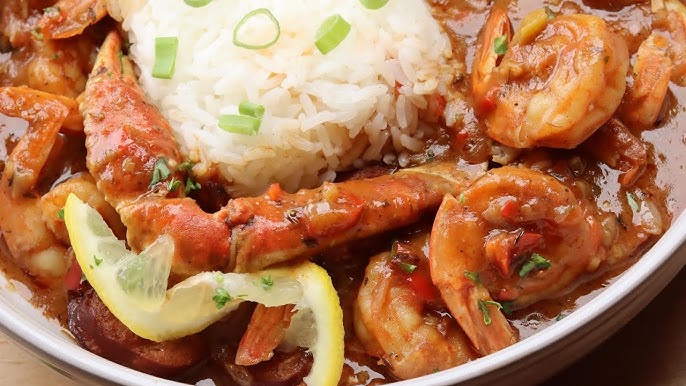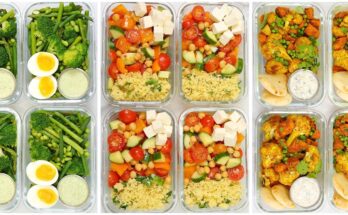Seafood Gumbo Recipe: Seafood gumbo is a warm, hearty dish that’s bursting with bold flavors and rich traditions. As a staple in Creole and Cajun cuisine, this dish combines fresh seafood, aromatic vegetables, and a luscious roux to create a one-pot masterpiece. Whether you’re new to gumbo or a seasoned cook, this step-by-step guide will help you make a flavorful pot of seafood gumbo that will impress any crowd.
What Is Seafood Gumbo?
Seafood gumbo is a flavorful stew originating from Louisiana, blending African, French, Spanish, and Native American culinary influences. Traditionally, gumbo is thickened with either okra or file powder (ground sassafras leaves) and served over rice. While there are many variations of gumbo, seafood gumbo stands out for its use of shrimp, crab, oysters, and other seafood that infuses the dish with a distinct coastal flavor.
Gumbo is a celebration of diversity and adaptability, making it an ever-evolving recipe. While traditional recipes stay close to their roots, modern interpretations allow for creative twists and substitutions.
Ingredients for Seafood Gumbo
To make the perfect seafood gumbo, you’ll need a combination of fresh ingredients and pantry staples. Here’s a detailed breakdown:
Fresh Seafood
- Shrimp: Peeled and deveined, with shells reserved for stock.
- Crab: Blue crab or lump crab meat works well.
- Oysters: Optional but highly recommended for an authentic flavor.
- Other Options: Crawfish tails, scallops, or mussels.
Aromatics and Vegetables
The “holy trinity” of Cajun cooking—onion, celery, and bell pepper—forms the flavor base of gumbo. You’ll also need garlic, green onions, and parsley for added aroma.
Roux
The roux is the heart of gumbo. It’s made by cooking equal parts flour and oil until it reaches a deep brown color. A dark roux adds a nutty, rich flavor and thickens the gumbo.
Spices and Seasonings
- Cajun or Creole seasoning blend
- Bay leaves
- Dried thyme
- Paprika
- Cayenne pepper (adjust for heat preference)
- Hot sauce
Other Ingredients
- Seafood stock (homemade or store-bought)
- Tomatoes (diced or canned)
- Okra or file powder for thickening
Kitchen Tools You’ll Need
- Large Dutch Oven or Stockpot: Essential for even cooking and heat retention.
- Whisk: For making the roux.
- Ladle: To serve gumbo.
- Sharp Knife and Cutting Board: For chopping vegetables and prepping seafood.
How to Make Seafood Gumbo – Step-by-Step
Step 1 – Preparing the Ingredients
Start by cleaning and prepping all your ingredients. Peel and devein the shrimp, reserving the shells to make a quick seafood stock if desired. Chop the onion, celery, bell pepper, and garlic into small, uniform pieces for even cooking.
Step 2 – Making the Roux
In a large Dutch oven, heat ½ cup of oil over medium heat. Gradually whisk in ½ cup of flour, stirring constantly to prevent lumps. Cook the roux for 20–30 minutes, or until it turns a rich chocolate brown. Be patient—this step builds the base flavor of your gumbo.
Step 3 – Building the Base
Add the chopped onion, celery, and bell pepper to the hot roux, sautéing until softened. Stir in the garlic, bay leaves, thyme, and Cajun seasoning, letting the spices bloom for about 2 minutes. Add diced tomatoes and cook for another 5 minutes.
Step 4 – Simmering the Gumbo
Slowly pour in the seafood stock, whisking constantly to combine. Bring the mixture to a gentle boil, then reduce the heat to low. Add sliced okra (or file powder) to thicken the gumbo, stirring occasionally. Let the gumbo simmer for 45 minutes to an hour to develop deep, rich flavors.
Step 5 – Cooking the Seafood
Add the shrimp, crab, and oysters to the pot during the last 10–15 minutes of cooking. Be careful not to overcook the seafood; shrimp should turn pink, and crab should be heated through.
Serving Suggestions for Seafood Gumbo
Seafood gumbo is best served over fluffy white rice with a sprinkle of green onions and fresh parsley. Add a dash of hot sauce for extra heat, and pair it with crusty French bread for dipping. For a festive touch, serve with lemon wedges and a side of potato salad—a classic Southern pairing.
Tips for Perfect Seafood Gumbo
- Don’t Rush the Roux: A properly cooked roux is key to the flavor. Stir constantly and be patient.
- Balance the Heat: Adjust the spice level to your liking by adding cayenne pepper and hot sauce gradually.
- Choose Fresh Seafood: Fresh ingredients make all the difference, but frozen seafood works in a pinch.
- Avoid Overcooking Seafood: Add seafood at the end to keep it tender and juicy.
Storing and Reheating Seafood Gumbo
Seafood gumbo tastes even better the next day! Store leftovers in an airtight container in the refrigerator for up to 3 days. Reheat gently over low heat, adding a splash of water or stock if needed. Avoid microwaving to prevent overcooking the seafood.
Variations of Seafood Gumbo
- Sausage and Chicken Gumbo: Swap seafood for smoked sausage and chicken thighs.
- Vegan Gumbo: Use mushrooms, zucchini, and vegetable stock with a plant-based roux.
- Gluten-Free Gumbo: Substitute all-purpose flour with a gluten-free alternative.
FAQs about Seafood Gumbo Recipe
What is seafood gumbo?
Seafood gumbo is a hearty, flavorful stew from the culinary traditions of Louisiana. It typically features a variety of seafood such as shrimp, crab, and sometimes oysters, combined with a rich base of roux (a cooked mixture of flour and fat), vegetables like okra, bell peppers, onions, and celery, seasoned with spices and served over rice.
What type of seafood can I use in gumbo?
You can use a variety of seafood in gumbo, depending on your taste and availability. Common choices include shrimp, crabmeat, oysters, and fish like catfish or tilapia. For the best flavor, use fresh seafood or high-quality frozen options.
Do I have to use okra in my gumbo?
Okra is traditional for thickening gumbo and adding a distinct flavor, but it’s not mandatory. If you’re not a fan of okra, you can use file powder (ground sassafras leaves) as an alternative thickener, which is added after the gumbo is cooked.
How do I make a roux for gumbo?
To make a roux for gumbo, heat equal parts flour and fat (usually oil or butter) in a heavy skillet over medium heat. Constantly stir the mixture for about 15 to 20 minutes until it turns a dark brown color. This process requires patience and continuous stirring to prevent burning.
Can I make seafood gumbo in advance?
Yes, gumbo tastes even better when made a day in advance. This allows the flavors to meld together. Store it in the refrigerator and gently reheat it on the stove before serving. Be sure to check the seasoning and adjust if necessary.
Is gumbo gluten-free?
Traditional gumbo is made with a roux that contains flour, which is not gluten-free. However, you can make a gluten-free version by substituting the flour with a gluten-free alternative like rice flour or by using cornstarch as a thickener.
What’s the best way to serve gumbo?
Gumbo is best served hot over a bed of freshly cooked rice. Garnish with chopped green onions or parsley and offer hot sauce on the side for those who prefer an extra kick.



